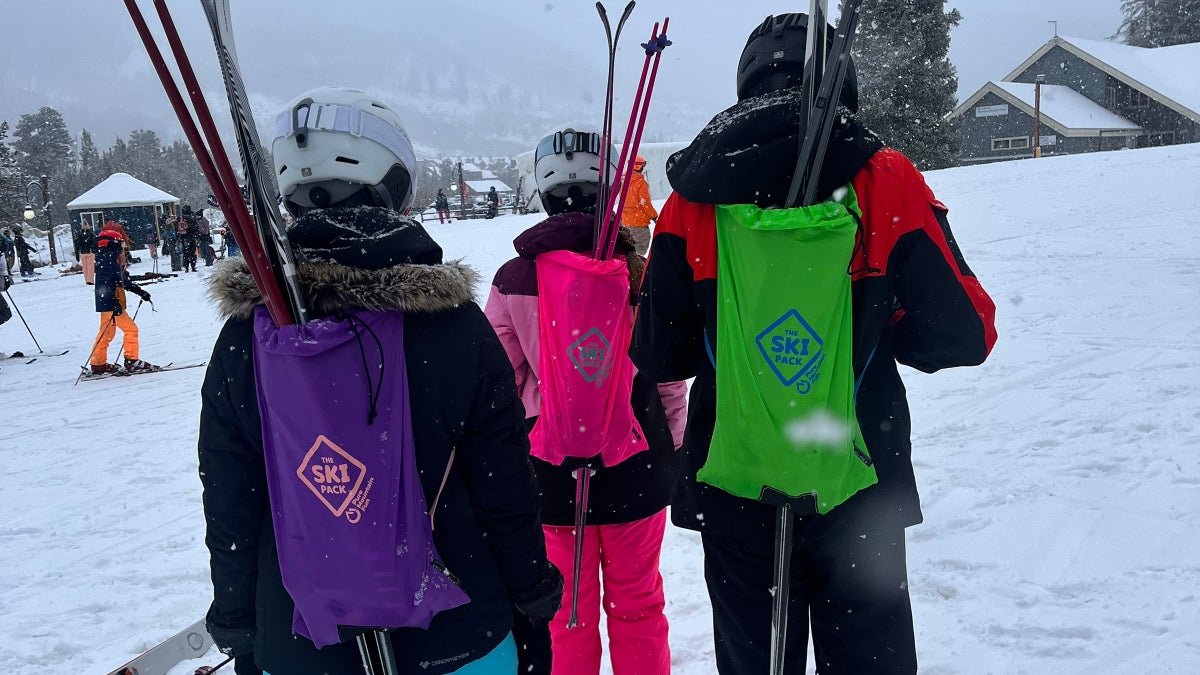
I was smoked, shellacked, completely and utterly exhausted. It was a bluebird afternoon in late-March, and I had just finished a full day of skiing with my five-year-old daughter at Colorado’s Keystone Resort.
My lower back throbbed from the several-dozen times I’d scooped her up from the snow. Carrying my skis and poles in one hand, her skis under an arm, and her hand in mine, I awkwardly hobbled through Keystone’s base area toward the bus. One thought echoed through my head: I gotta find a better way to carry all of this crap.
The very next morning, while riding the ski bus, I glanced over and saw a guy using a device I’d never seen before: a neon bag that enveloped his bindings with a drawstring at the top, and slits on the top and bottom allowed the ski tips and tails to protrude. His wife and kids, seated next to him, also had bags on their skis. When the four of them stood up, they wore their skis and poles like backpacks.
The man introduced himself as Philip Peterson, unzipped his jacket, and tossed me one to try. I couldn’t believe how small and lightweight it was—it crumpled down to the size of a handkerchief in my pocket.
Philip told me that the device, called The Ski Pack, was sold by a company called Pure Mountain Fun that he co-owned. I asked him how he had come up with such a cool and innovative design. He smiled.
“My son and his friend invented it,” he told me.
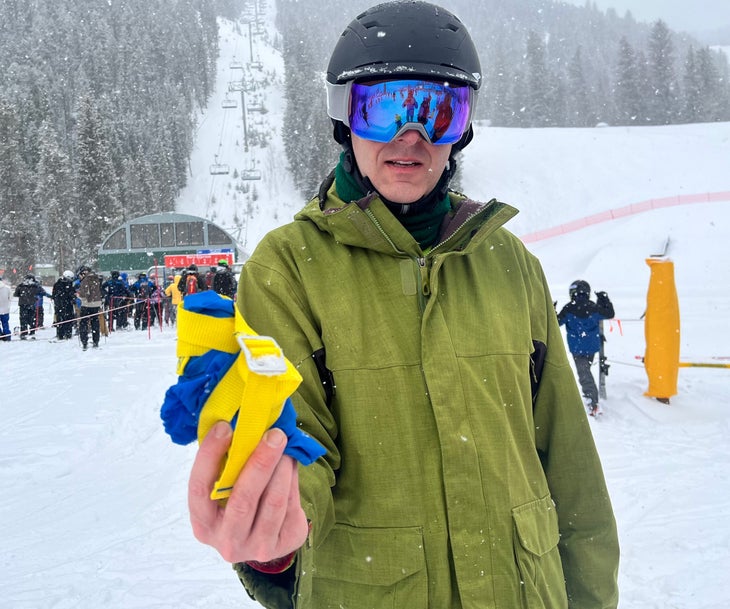
How Two Kids Invented a Game-Changing Ski Bag
News flash: skiing with small children is hard. Really hard. You have to juggle meltdowns, snack time, weather conditions, and yeah, tons of gear. To hang out at a typical ski resort’s kiddie area is to see dozens of parents finding creative ways to schlep skis, boots, water bottles, helmets, and yes, the occasional rag doll-like toddler, across the snow.
The Ski Pack was born from this epic struggle. Back in 2020, Philip Peterson’s son, Zachary, was a fourth-grader at Redstone Elementary in Highlands Ranch, Colorado. He and his friend, Madeline Gacnik were both involved in an extracurricular activity called Destination Imagination, which prompts kids to find creative solutions to everyday problems.
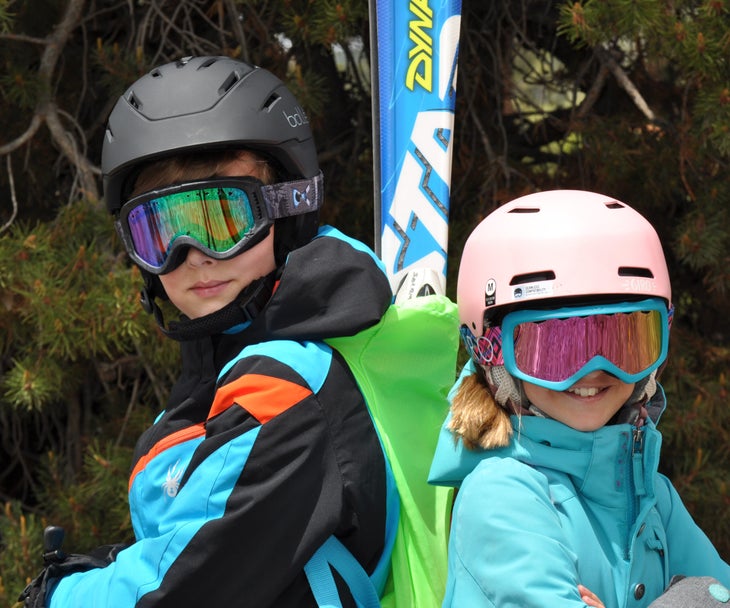
Anyone who is familiar with the long-running kids’ programs Odyssey of the Mind or Olympics of the Mind is familiar with the concept.
Both the Peterson and Gacnik families were passionate skiers, and the kids’ problem solving idea stemmed from their own trips to the resort.
“They originally wanted to solve world hunger, and we had to rein them in a bit,” Phillip, who works for the Colorado Department of Public Health, told me. “The problem they moved to next was that parents get tired of carrying their kids’ skis and they could get more ski days in if kids could carry their own skis.”
No notes from me on this logic.
The kids had two months and a $100 budget to create their prototype before presenting it to a panel of adults. Julia Gacnik, Madeline’s mother, told me that the families took regular trips to Hobby Lobby to examine fabrics suitable for carrying skis. Then, the kids had to investigate various designs that solved the problems of other minimalist ski carriers.
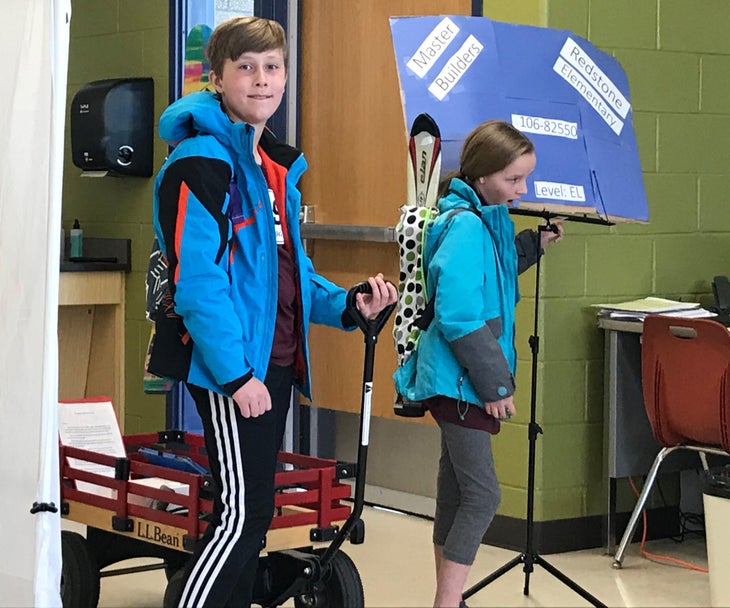
“If you’re putting a basic shoulder ski strap on a three-year-old, they’re going to be hitting cars and scratching up their skis,” said Julia, who works in data analytics. “We’d prompt the kids with these scenarios. How should it fit? What should you do with it when you get to the ski lift? What should it look like?”
The questions helped Madeline and Zachary zero in on a concept. The bag should fit like a backpack, they decided, because young children are accustomed to wearing backpacks. The bag should be made from lightweight and collapsible fabrics. When not being used, it should be able to fit in the pocket of a toddler’s jacket.
The original prototype was made from Colorado Rockies-branded fleece. Julia helped the kids sew it together on the Gacnik family dinner table. But it had a flaw.
“It didn’t dry very well and it didn’t have adjustable straps,” Julia said. Employees at Hobby Lobby pointed the kids toward a nylon ripstop fabric instead. That material worked better, and the kids’ designs evolved around it.
After two months, Zachary and Madeline presented their product to the Destination Imagination panel, who offered feedback. There are no winners in the activity. But with the project done, the kids’ still saw room for improvement, and their parents encouraged them to continue working on it.
Julia said a lightbulb went on in her own head during one of her family ski trips. The Gacniks have four children, and all of them were using the bags as they walked through the parking lot.
“It was the end of the day when kids are usually in meltdown mode and we walked in peace and quiet. There were no tears, no struggle,” she said. “It was validating, like ‘hey, we’re onto something.’”
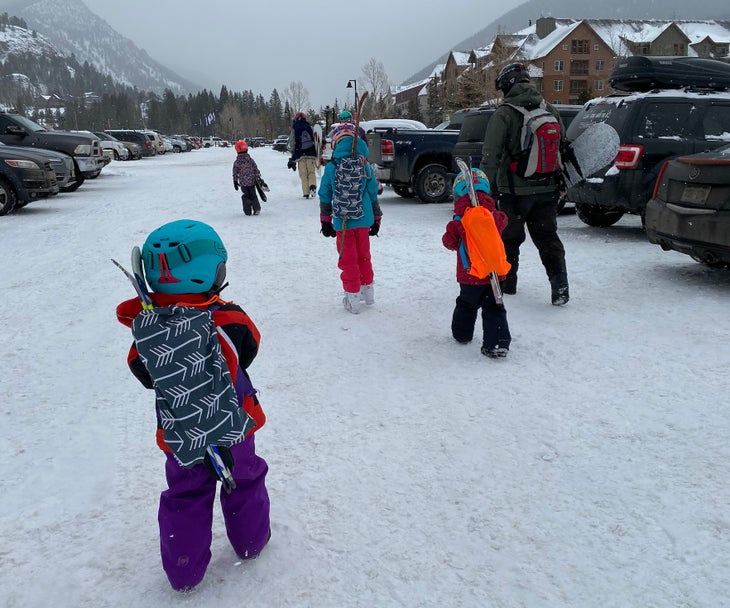
The Gacnik and Peterson family decided to safeguard the design. They filed for a patent in 2020 and founded a company later that year. They began selling it through word-of-mouth and also to parents’ ski groups. The product evolved too, and the kids’ eventually sourced reused parachute nylon for the bags. The design also evolved.
Right now, the current model is on sale for $36.
“Every parent is proud of their child, but seeing my kid go through this—sewing a product together, evolving it, pitching it to adults—made me so proud,” Phillip said. “To see Zachary and Madeline grow this way has been special.”
Testing the Ski Pack on the Slopes
Whether or not to bring a backpack has become the seminal question of my ski days.
Before having kids, I’d only bring my pack when I planned to bootpack to expert terrain. But when I started skiing with my daughter, the backpack became a semi-permanent part of my setup, specifically so I could A-frame my skis for the trudge back to the bus. In truth, I dislike skiing with a pack—no matter the design, all of them are hot and cumbersome on a chairlift. I miss the carefree days of hitting the slopes pack-free.
My assessment of The Ski Pack was borne of that experience: could I enjoy a day on the slopes—half of the day by myself, the other half with my kiddo—without the crutch of my backpack?
The first part of my day went swimmingly. After placing my own skis in the Ski Pack, I walked with ease to the chairlift. Sure, it took a few moments to adjust the straps to my torso and to dial in a snug fit. But after that initial monkeying with the product, I was off.
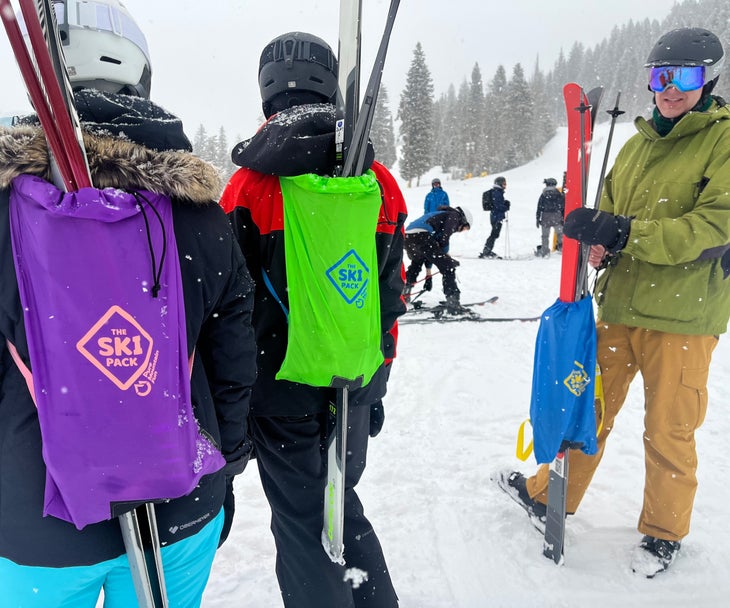
The Ski Pack’s magic was most evident when I wasn’t using it. I folded it into a wad no bigger than a roll of kids’ socks and just tucked it into my pocket. I never felt a bulge in my side, nor did I inadvertently bump into something due to a protruding pocket. I just forgot about it.
Hours later, when it was time to go home, I produced the Ski Pack, tucked my kiddo’s skis into it, and wore it like a backpack. My wife wore it, too. We even put it on my daughter and had her walk around wearing her skis. It was that simple.
I have minor quibbles about The Ski Pack. The shoulder harnesses are not connected by a cross-chest strap to better distribute the weight of your skis. There’s also no padding on the shoulder harnesses, so if you have a thin jacket, you might feel a pinch. Both issues are harder on adults, due to our heavier skis. My daughter never complained.
Of course these two additions may alleviate these problems, but they would also add to The Ski Pack’s overall bulk—and the product’s minimalist size is the key to its success.
“I think as adults inclined to overcomplicate designs with additions,” Philip Peterson told me. “The kids wanted something extremely simple.”
I have no clue what the future holds for The Ski Pack. Phillip told me that the product is at a crossroads, as both Zachary and Madeline are now teenagers who have obligations and interests outside of the company. They’ve had to change manufacturers recently, and both families are in talks about what to do next with the whole project.
I sincerely hope they keep it going. After all, skiing with your kiddo isn’t going to get any easier. The Ski Pack solves a big part of the struggle.
The post This Tiny Ski Bag Is a Game Changer for Parents. It Was Designed by Two Colorado Kids. appeared first on Outside Online.















